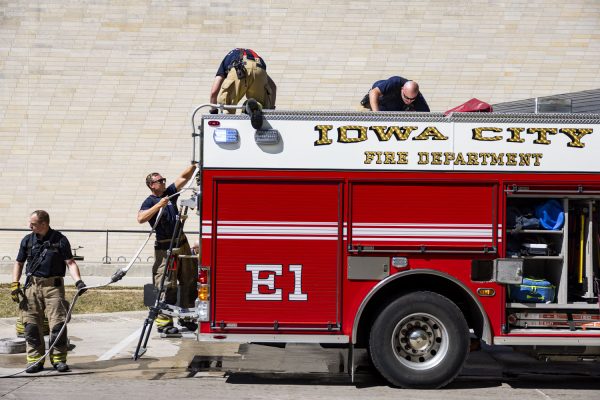Reports of violent crime declined in Iowa City in 2020
Though Iowa’s reported crime rate rose by 9.5 percent in 2020, violent crimes in Iowa City decreased.
Iowa City Police Department vehicles are seen on July 9, 2019.
October 26, 2021
Reported violent crimes in Iowa increased this year to the highest level since 2018, but the rate in Iowa City went down over the same year.
The rate of reported violent crimes in the state of Iowa went up 9.5 percent from 2019 to 2020, but reported violent crimes in Iowa City went down by 8.7 percent, according to the Federal Bureau of Investigation.
The FBI defines violent crime in four offenses:
- Murder and nonnegligent manslaughter
- Forcible rape
- Robbery
- Aggravated assault
Lee Hermiston, the Iowa City Police Department’s public safety information officer, attributed the decline in reported violent crime in Iowa City to the COVID-19 pandemic.
“Unfortunately, we know that crime is cyclical. Iowa City has seen multiple homicides and shots fired incidents this year,” he wrote in an email to The Daily Iowan. “We continue to investigate those crimes to the fullest extent possible.”
The FBI crime database cannot account for all crimes, just those that are reported.
The Domestic Violence Intervention Program, an Iowa City organization, provides resources to those who may be experiencing an abusive environment.
“In May of 2020, we began to see a 28 percent increase in our hotline calls each month,” said Alta Medea-Peters, the program’s director of community engagement. “Since that point we have seen that same increase.”
RELATED: Johnson County Supervisors to discuss use of federal funds to track domestic abusers
The Domestic Violence Intervention Program is not a mandatory reporter of domestic violence, which means that if it hears from callers seeking help in its programs or hotline, the workers there are not legally obligated to report these incidents to law enforcement.
“A lot of times what we see is different than what law enforcement sees,” Medea-Peters said. “Because individuals are mostly looking to make a safety plan and get out of a dangerous situation, not necessarily is it in their best interest to always use law enforcement, or the judicial system.”
According to the Crime Data Explorer, of all reported violent crimes in 2020 and 2021, 28 percent of perpetrators were boyfriends and girlfriends and 5 percent were spouses.
Exactly one-third of the violent crimes were committed by romantic partners.
“The pandemic made it so much more difficult for victims to be able to reach out and connect with resources,” said Kristie Fortmann-Doser, executive director for the Domestic Violence Intervention Program.
Fortmann-Doser said COVID-19 and quarantine made it more difficult for victims and survivors to make safety plans.
“They may not be able to go stay with a family member for fear of infecting them,” Fortmann-Doser said. “If a family member, like a parent, has significant health issues in a pandemic, you’re not going to go there where you might have taken a break for some immediate safety with your mom.”
Medea-Peters said the best thing anyone can do when someone leaves a domestic abuse situation is to believe them and offer financial support.
“When people are fleeing a dangerous situation, they don’t often take more than what’s on their back,” Medea-Peters said.
Fortmann-Doser said leaving a domestically violent environment is much harder and more complicated than simply reporting the violent crime, because sometimes the victim is the only witness.
“The level of leverage that a batterer has is very different from most other criminals,” Fortmann-Doser said. “Batterers have access to everything about you.”













